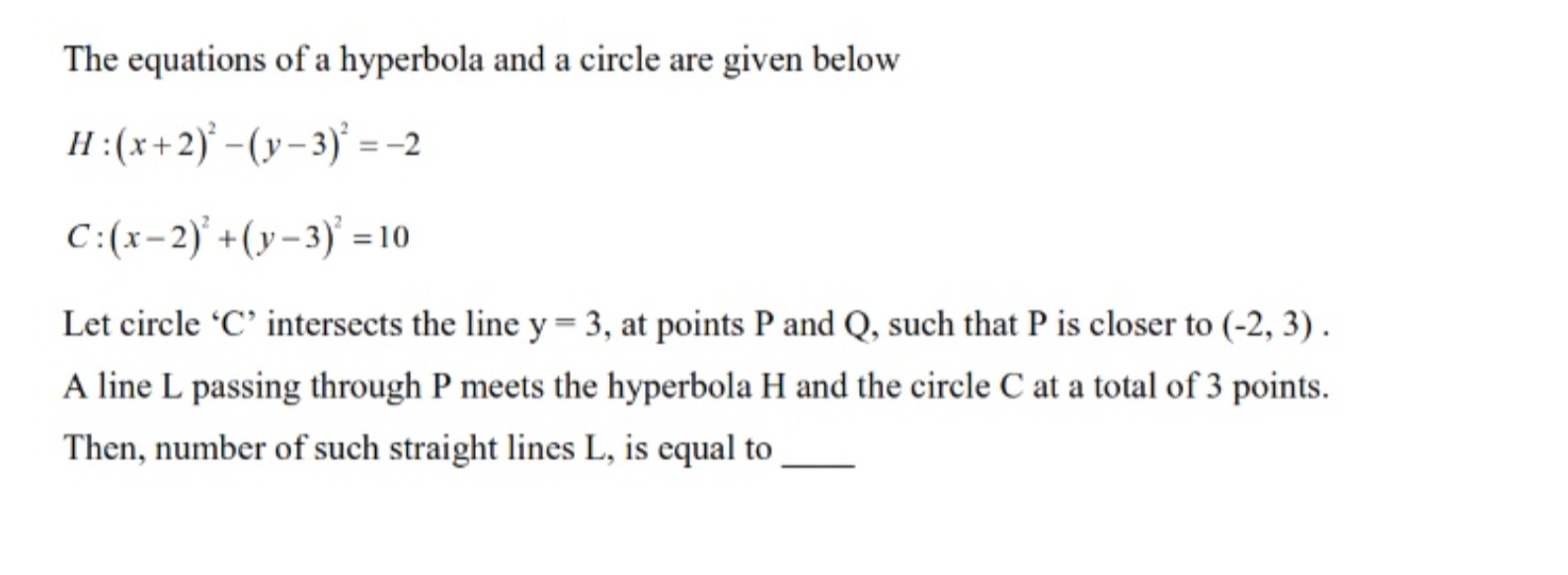Question
Question: The equations of a hyperbola and a circle are given below $H:(x+2)^2 - (y-3)^2 = -2$ $C:(x-2)^2+(y-...
The equations of a hyperbola and a circle are given below
H:(x+2)2−(y−3)2=−2 C:(x−2)2+(y−3)2=10
Let circle 'C' intersects the line y = 3, at points P and Q, such that P is closer to (-2, 3).
A line L passing through P meets the hyperbola H and the circle C at a total of 3 points.
Then, number of such straight lines L, is equal to ____

2
Solution
Solution:
-
The circle is
(x−2)2+(y−3)2=10.Its intersection with the horizontal line y=3 gives
(x−2)2=10⟹x=2±10.Since the point closer to (−2,3) will have the smaller x-value, we get
P=(2−10,3). -
Let a line L through P be
y−3=m(x−(2−10)).This line meets the circle C at P and (generically) at another point Q.
-
For the union of intersections with the hyperbola and circle to total 3 distinct points, the line must intersect one of the conics in a double (tangent) manner. Since P is fixed on the circle and is not on the hyperbola, the only possibility is to have the line tangent to the hyperbola
(x+2)2−(y−3)2=−2,so that L and H meet in a single (double) point while L meets C in two distinct points (namely, P and Q).
-
Substitute y−3=m(x−(2−10)) into H:
(x+2)2−[m(x−(2−10))]2=−2.Rewriting,
(x+2)2−m2(x−(2−10))2+2=0.This is a quadratic in x. For the line to be tangent to H the discriminant must be zero.
-
Writing the quadratic in the form
Ax2+Bx+C=0,after expanding we obtain:
(1−m2)x2+[4+2m2(2−10)]x+[6−m2(2−10)2]=0.Tangency requires
[4+2m2(2−10)]2−4(1−m2)[6−m2(2−10)2]=0. -
Simplify by letting α=2−10. Then,
[4+2m2α]2−4(1−m2)[6−m2α2]=0.Factor 2 from the first bracket:
4(2+m2α)2−4(1−m2)[6−m2α2]=0.Dividing by 4 and expanding yields:
(2+m2α)2−(1−m2)(6−m2α2)=0.Expanding further,
4+4m2α+m4α2−[6−6m2−m2α2+m4α2]=0.The m4α2 terms cancel and we get:
4+4m2α+6m2+m2α2−6=0.That simplifies to:
m2(α2+4α+6)=2. -
Now compute α2:
α2=(2−10)2=4−410+10=14−410.Thus,
α2+4α+6=(14−410)+4(2−10)+6=14−410+8−410+6=28−810.So,
m2=28−8102=4(7−210)2=2(7−210)1. -
Since m2 is positive, there are 2 possible real values of m (namely m=±2(7−210)1). Hence, there are 2 lines L which satisfy the given condition.
Explanation (minimal):
- Find P=(2−10,3) from circle C along y=3.
- A line through P: y−3=m(x−(2−10)) meets C in P and Q.
- To have a total of 3 intersections with C and hyperbola H, L must be tangent to H.
- Substitute the line in H, set the quadratic discriminant to zero, simplify to get: m2(α2+4α+6)=2,α=2−10.
- Compute α2+4α+6=28−810 and solve to get two possible slopes.
- Thus, the number of such lines L is 2.
